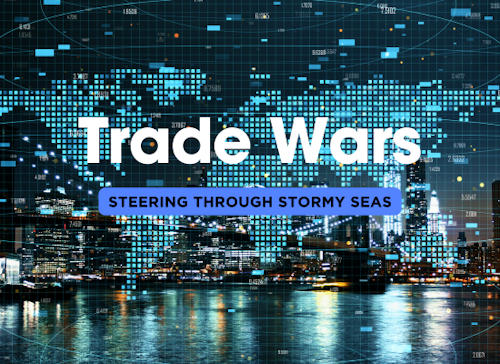Tariffs, Trade Wars and Maritime Routes: How Shipping is Steering Through Stormy Seas

Global trade is the backbone of the world's economy, with shipping routes connecting continents and enabling the movement of goods. Major routes such as the Trans-Pacific, Trans-Atlantic, and Asia-Europe corridors play a critical role in facilitating international commerce. However, the rise of trade wars poses significant challenges to these established routes, disrupting the flow of goods and creating uncertainty in the market.
Historically, trade wars have been driven by protectionist policies aimed at shielding domestic industries from foreign competition. Understanding the impact of these trade conflicts on global shipping routes is crucial for stakeholders to adapt and strategize for future uncertainties. This article delves into the causes and effects of trade wars, with a focus on how they reshape the landscape of maritime shipping.
| ShipUniverse: Impact of Trade Wars on Global Shipping Routes | ||||
|---|---|---|---|---|
| Trade War | Affected Routes | Key Changes in Trade Patterns | Economic Impact on Ports | Impact on Shipping Companies |
| US-China Trade War | Trans-Pacific | Shift of imports from China to Southeast Asia | Decreased container volumes at Chinese ports like Shanghai and Shenzhen | Maersk, COSCO, and other major carriers saw reduced revenues on US-China routes |
| US-EU Trade Disputes | Trans-Atlantic | Tariffs on goods affecting trade volumes between US and EU | Ports in the US and EU experienced fluctuations in trade volumes | Increased operational costs due to rerouting and tariff management |
| US-Mexico-Canada (USMCA) | North American Free Trade Routes (NAFTA) | Stabilization and slight increase in intra-North American trade | Ports in Mexico and Canada saw increased trade activity | Companies with strong North American links benefited from reduced uncertainty |
| Japan-South Korea Trade Dispute | East Asia routes | Diversification of supply chains away from South Korea | Japanese and South Korean ports saw shifts in trade volumes | Companies like Hyundai and Mitsubishi had to navigate new trade barriers |
| Brexit | EU-UK Routes | New customs checks and trade barriers between the UK and EU | UK ports like Dover experienced delays and increased costs | UK-based shipping firms had to adapt to new regulatory environments |
| India-China Trade Tensions | Indian Ocean, South China Sea | Reduced bilateral trade, increased trade with ASEAN countries | Indian ports like Mumbai saw increased imports from ASEAN | Indian shipping companies diversified their trade routes |
| US-Iran Sanctions | Persian Gulf, Strait of Hormuz | Decreased oil exports from Iran, increased imports from other Gulf states | Iranian ports experienced significant declines in activity | Global shipping companies avoided Iranian routes due to sanctions |
| Russia-EU Sanctions | Baltic Sea, Black Sea | Reduced trade between Russia and EU, increased trade with Asia | Ports in the Baltic states and Russia saw changes in trade volumes | European shipping companies had to find alternative routes for Russian goods |
| Australia-China Trade Dispute | Asia-Pacific routes | Diversification of Australian exports away from China | Australian ports like Sydney and Melbourne sought new markets | Australian exporters and shipping firms had to navigate new trade dynamics |
| Turkey-US Trade Dispute | Mediterranean, Aegean Sea | Fluctuations in trade volumes due to tariffs on steel and aluminum | Turkish ports like Istanbul saw changes in trade patterns | Turkish shipping companies faced increased operational costs |
Background on Trade Wars
Trade wars are conflicts that arise when countries impose tariffs or other trade barriers on each other’s goods, often leading to a cycle of retaliation. The main causes of trade wars include:
- Economic Protectionism: Governments implement measures to protect domestic industries from foreign competition, aiming to boost local employment and production.
- Trade Imbalances: Countries with significant trade deficits may seek to reduce imports and promote exports to balance their trade.
- Political Disputes: Geopolitical tensions and disagreements can lead to the imposition of trade restrictions as a form of economic leverage.
Key Trade Wars in Recent History
- US-China Trade War: Initiated in 2018, this trade conflict focused on issues such as intellectual property theft, trade deficits, and technology transfer. The US imposed tariffs on billions of dollars’ worth of Chinese goods, prompting China to retaliate with tariffs on American products. This trade war had profound implications for global supply chains and shipping routes.
- US-EU Trade Disputes: Long-standing disputes over subsidies to aerospace giants Boeing and Airbus resulted in the imposition of tariffs on a wide range of goods from both sides. These disputes highlighted the interconnected nature of global trade and the ripple effects of tariffs on various industries.
Overview of Trade Policies and Tariffs Involved
- Tariffs: These are taxes imposed on imported goods, which increase the cost of these goods and make them less competitive in the importing country. Tariffs are often used as a tool to protect domestic industries.
- Quotas: Limits set on the quantity of a particular good that can be imported into a country. Quotas are designed to restrict the supply of foreign goods and boost local production.
- Subsidies: Financial assistance provided by governments to domestic industries to enhance their competitiveness against foreign imports. Subsidies can take various forms, including direct financial aid, tax breaks, and favorable loans.
Direct Impact on Shipping Routes
Trade wars lead to a decrease in trade volumes between warring countries. Importers and exporters seek alternative markets, redirecting trade to new partners. For example, during the US-China trade war, US importers shifted from Chinese to Southeast Asian suppliers, changing the dynamics of established shipping routes.
Shifts in Major Shipping Routes
- Diversion from Traditional Routes: Major routes such as the Trans-Pacific corridor saw decreased traffic, while routes involving Southeast Asia or Latin America became more prominent.
- Increased Use of Secondary Ports: To circumvent tariffs, shippers began using secondary ports, altering the flow of global trade.
Case Studies: Specific Examples of Route Changes
- US Importers: Shifted from Chinese to Southeast Asian suppliers, altering shipping routes.
- European Exporters: Found new markets in Africa and the Middle East, diversifying their shipping routes.
Economic Consequences
- Impact on Shipping Costs and Freight Rates: Increased costs due to longer routes and additional logistics. Fluctuations in freight rates as supply-demand dynamics shift.
- Effects on Global Supply Chains and Logistics: Disruption in the just-in-time supply chain model. Increased inventory costs and supply chain complexities.
- Case Studies: Economic Impact on Major Ports and Shipping Companies: Decline in container volumes at major Chinese ports. Financial strain on shipping companies with heavy exposure to affected routes.
Economic Consequences
Impact on Shipping Costs and Freight Rates
- Increased Costs: Trade wars often lead to increased shipping costs due to longer routes, additional logistics, and the need to find alternative suppliers. For example, rerouting goods to avoid tariffs can significantly raise fuel and operational expenses.
- Freight Rate Fluctuations: The supply-demand dynamics shift as trade volumes change. Ports and shipping lanes experiencing reduced traffic may see lower freight rates, while new or expanded routes might face higher rates due to increased demand.
Effects on Global Supply Chains and Logistics
- Disruption of Just-in-Time Models: Companies that rely on just-in-time inventory systems face disruptions as trade wars lead to delays and uncertainties. This results in increased inventory costs and the need for more complex supply chain management.
- Complex Logistics: Finding new suppliers and markets requires reconfiguring logistics networks. This complexity can lead to inefficiencies and higher costs, affecting the overall performance of global supply chains.
Case Studies: Economic Impact on Major Ports and Shipping Companies
- Chinese Ports: Major Chinese ports, like Shanghai and Shenzhen, experienced declines in container volumes as US tariffs reduced American imports from China.
- Shipping Companies: Companies with significant exposure to affected routes faced financial strain. For instance, Maersk reported lower revenues on key trade lanes impacted by the US-China trade war, highlighting the broader economic consequences.
Geopolitical Implications
Influence on International Maritime Policies and Regulations
- Shifting Alliances: Trade wars can lead to shifts in international alliances and trade agreements. Countries may seek new partners to offset the loss of traditional trade routes, leading to changes in maritime policies and regulations.
- New Trade Agreements: In response to trade wars, countries may negotiate new trade agreements to secure alternative markets. For instance, the Comprehensive and Progressive Agreement for Trans-Pacific Partnership (CPTPP) gained importance as countries sought to diversify trade away from the US-China conflict.
Changes in Alliances and Partnerships among Countries
- Diversification of Trade Partners: Countries affected by tariffs diversify their trade partners, leading to new alliances and partnerships. This diversification helps mitigate the risks associated with trade wars but also reshapes global trade dynamics.
- Regional Trade Blocs: The rise of regional trade agreements, such as the Regional Comprehensive Economic Partnership (RCEP) in Asia, highlights the trend towards regionalism as countries seek to strengthen intra-regional trade links.
Case Studies: Geopolitical Shifts in Response to Trade Wars
- China and Belt and Road Initiative: In response to the US-China trade war, China accelerated its Belt and Road Initiative (BRI), investing in infrastructure projects across Asia, Europe, and Africa to secure new trade routes and markets.
- US and Latin America: The US sought to enhance trade relations with Latin American countries as an alternative to Chinese imports, leading to increased trade agreements and partnerships in the region.
Adaptation Strategies by the Shipping Industry
Diversification of Trade Routes and Markets
- Exploring New Markets: Shipping companies and exporters have diversified their markets to reduce reliance on any single trade route. For example, during the US-China trade war, many US businesses increased imports from Southeast Asia.
- Alternate Shipping Lanes: Utilizing alternative shipping routes, such as the Northern Sea Route through the Arctic, to avoid tariffs and reduce transit times.
Technological Innovations and Efficiencies in Shipping
- Automation and Digitalization: Embracing automation and digital technologies to enhance operational efficiency and reduce costs. Technologies like blockchain are being used to improve transparency and security in shipping transactions.
- Fuel Efficiency and Environmental Compliance: Investing in greener technologies to comply with environmental regulations and reduce operational costs. The adoption of LNG-powered ships and scrubber installations are examples of such initiatives.
Role of Digitalization and Data Analytics in Route Optimization
- Predictive Analytics: Using data analytics to predict and respond to disruptions in shipping routes. This helps in planning and optimizing routes for cost and time efficiency.
- Real-Time Tracking: Implementing advanced tracking systems to monitor the movement of goods in real-time, ensuring timely adjustments to shipping routes and schedules.
Case Studies: Adaptation Strategies in Action
- Maersk’s Digital Transformation: Maersk has invested heavily in digital solutions, including the use of blockchain for shipping documentation, to streamline operations and reduce costs.
- Alternative Sourcing by Retailers: Companies like Walmart and Target diversified their supply chains by sourcing more products from countries like Vietnam and India during the US-China trade tensions.
Long-term Effects and Future Outlook
Potential Long-term Changes in Global Trade Dynamics
- Shift in Trade Powerhouses: Continued trade wars may shift the balance of global trade power, with emerging markets gaining prominence as key trade partners.
- Regionalization of Trade: The trend towards regional trade agreements and blocs may strengthen, reducing dependency on traditional global trade routes.
Predictions for Future Shipping Routes and Trends
- Increased Use of Arctic Routes: As climate change makes Arctic routes more accessible, there may be a significant increase in their use for shipping between Asia and Europe.
- Greater Flexibility and Adaptability: Shipping companies will likely become more agile, using flexible routing and diversified supply chains to mitigate the impact of future trade conflicts.
Role of International Cooperation in Mitigating Negative Impacts
- Strengthening Trade Agreements: International cooperation through trade agreements can help stabilize global trade and reduce the volatility caused by trade wars.
- Global Regulatory Standards: Establishing and adhering to global standards for maritime operations can ensure smoother and more predictable trade flows.
Case Studies: Long-term Effects and Strategies
US-Mexico-Canada Agreement (USMCA): This agreement replaced NAFTA and aimed to create a more balanced trade environment in North America, providing a framework for resolving trade disputes and promoting regional trade stability.
China’s Belt and Road Initiative: By investing in infrastructure across Asia, Africa, and Europe, China aims to create new trade routes and reduce dependency on traditional shipping lanes affected by trade wars.
Trade wars have significantly reshaped global shipping routes, disrupting established trade patterns and imposing new challenges on the maritime industry. As countries impose tariffs and other trade barriers, shipping companies and global supply chains must adapt quickly to maintain efficiency and profitability. Through diversification of trade routes, technological advancements, and increased international cooperation, the industry can mitigate some of the adverse effects and prepare for future uncertainties. The long-term outlook suggests a shift towards more flexible and regionally focused trade, underscoring the importance of agility and innovation in navigating these turbulent times. By understanding the impact of trade wars and implementing strategic adaptations, stakeholders in the maritime shipping industry can continue to thrive amidst global economic changes.
Additional References
World Trade Organization (WTO) - Trade Disputes
International Maritime Organization (IMO) - Regulatory Resources
U.S. International Trade Commission (USITC)
European Commission - Trade Policy
Bureau of Transportation Statistics (BTS) - Maritime Data
United Nations Conference on Trade and Development (UNCTAD) - Maritime Transport

Do you have a Maritime Product or Service that may be of interest to Shipowners? Tell us about it here!
Do you have feedback or insights? Please reach out to editor @ shipuniverse.com



